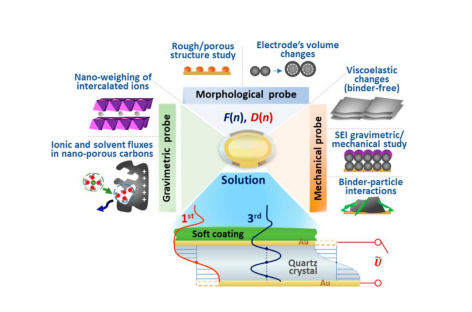22/12/2021 - 12:00 - 11:00
Add To Calendar
2021-12-22 11:00:00
2021-12-22 12:00:00
הרצאתו של ד"ר נתנאל שפיגל
השבוע תתקיים הרצאתו של ד"ר נתנאל שפיגל ביום רביעי 22/12 בשעה 11:00
ההרצאה תתקיים בחדר הסמינרים המחלקתי בין השעות 11:00-12:00
On the Use of EQCM-D for Real-Time Investigations of Batteries and Thin Films Characterization
Dr. Netanel Shpigel (Bar Ilan University, Drexel University)
The increasing demands of high energy and high power energy storage devices require significant improvement of current battery and supercapacitors electrodes materials and the development of new advanced electrode materials. To achieve this goal, a deeper understanding of the properties of the electrodes and their real-time dependence on the applied voltage, state-of-charge and cycling lifeis highly required. While information about the chemical and the crystalline nature of the electrodes can be obtained by using a variety of in-situ techniques like XRD, Raman, and FTIR, still, other important aspects related to the nature of the inserted ions, morphological variations, and the mechanical state of the electrodes cannot be provided by the conventionally used methods. In recent years, I am developing a new in-situ analytical approach to using electrochemical quartz crystal microbalance with dissipation monitoring (EQCM-D). In this technique, a piezoelectric quartz sensor sandwiched between two metallic layers is excited to resonance by the application of an alternating voltage. By adjusting the applied voltage, multiple resonance modes (also called harmonics) can be measured and the variations in the frequencies and the dissipation factor (f/n and D, respectively) are simultaneously monitored. The sensor is coated by a thin layer of the materials of interest and the changes in the properties of the layers after immersion in electrolyte solutions, and during intercalation/adsorption of ionic species are monitored by measuing multi harmonics response of both f/n and D. Fitting of the developed acoustic load impedance models to the recorded f/n and D values by suitable models allows extraction of real-time information of potential induced gravimetric, viscoelastic and morphological changes in operating electrodes and provides valuable information about their charging mechanism. In this lecture, the use of EQCM-D for in-situ monitoring of electrode materials for energy storage applications, including redox-type polymers, intercalation compounds, and capacitivetype electrodes will be described. The use of this method for the characterization of thin films will be discussed as well. The presented EQCM-D method may be used to gain a better understanding of the Department of Chemistry Faculty of exact sciences Bar-Ilan University charging mechanism and degradation pathways in electrode materials for further development of advanced batteries and supercapacitors. perovskite / silicon tandem solar cells.
Invitation (PDF)
חדר הסמינרים 211/112, zoom
Department of Chemistry
chemistry.office@biu.ac.il
Asia/Jerusalem
public
מיקום
חדר הסמינרים 211/112, zoom
השבוע תתקיים הרצאתו של ד"ר נתנאל שפיגל ביום רביעי 22/12 בשעה 11:00
ההרצאה תתקיים בחדר הסמינרים המחלקתי בין השעות 11:00-12:00
On the Use of EQCM-D for Real-Time Investigations of Batteries and Thin Films Characterization
Dr. Netanel Shpigel (Bar Ilan University, Drexel University)
The increasing demands of high energy and high power energy storage devices require significant improvement of current battery and supercapacitors electrodes materials and the development of new advanced electrode materials. To achieve this goal, a deeper understanding of the properties of the electrodes and their real-time dependence on the applied voltage, state-of-charge and cycling lifeis highly required. While information about the chemical and the crystalline nature of the electrodes can be obtained by using a variety of in-situ techniques like XRD, Raman, and FTIR, still, other important aspects related to the nature of the inserted ions, morphological variations, and the mechanical state of the electrodes cannot be provided by the conventionally used methods. In recent years, I am developing a new in-situ analytical approach to using electrochemical quartz crystal microbalance with dissipation monitoring (EQCM-D). In this technique, a piezoelectric quartz sensor sandwiched between two metallic layers is excited to resonance by the application of an alternating voltage. By adjusting the applied voltage, multiple resonance modes (also called harmonics) can be measured and the variations in the frequencies and the dissipation factor (f/n and D, respectively) are simultaneously monitored. The sensor is coated by a thin layer of the materials of interest and the changes in the properties of the layers after immersion in electrolyte solutions, and during intercalation/adsorption of ionic species are monitored by measuing multi harmonics response of both f/n and D. Fitting of the developed acoustic load impedance models to the recorded f/n and D values by suitable models allows extraction of real-time information of potential induced gravimetric, viscoelastic and morphological changes in operating electrodes and provides valuable information about their charging mechanism. In this lecture, the use of EQCM-D for in-situ monitoring of electrode materials for energy storage applications, including redox-type polymers, intercalation compounds, and capacitivetype electrodes will be described. The use of this method for the characterization of thin films will be discussed as well. The presented EQCM-D method may be used to gain a better understanding of the Department of Chemistry Faculty of exact sciences Bar-Ilan University charging mechanism and degradation pathways in electrode materials for further development of advanced batteries and supercapacitors. perovskite / silicon tandem solar cells.

Invitation (PDF)




